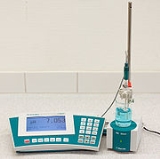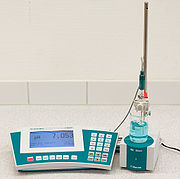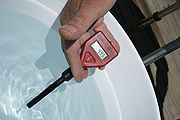
PH meter
Encyclopedia

PH
In chemistry, pH is a measure of the acidity or basicity of an aqueous solution. Pure water is said to be neutral, with a pH close to 7.0 at . Solutions with a pH less than 7 are said to be acidic and solutions with a pH greater than 7 are basic or alkaline...
(acid
Acid
An acid is a substance which reacts with a base. Commonly, acids can be identified as tasting sour, reacting with metals such as calcium, and bases like sodium carbonate. Aqueous acids have a pH of less than 7, where an acid of lower pH is typically stronger, and turn blue litmus paper red...
ity or alkalinity
Base (chemistry)
For the term in genetics, see base A base in chemistry is a substance that can accept hydrogen ions or more generally, donate electron pairs. A soluble base is referred to as an alkali if it contains and releases hydroxide ions quantitatively...
) of a liquid (though special probes are sometimes used to measure the pH of semi-solid substances). A typical pH meter consists of a special measuring probe (a glass electrode
Glass electrode
A glass electrode is a type of ion-selective electrode made of a doped glass membrane that is sensitive to a specific ion. It is an important part of the instrumentation for chemical analysis and physico-chemical studies. In modern practice, widely used membranous ion-selective electrodes are part...
) connected to an electronic meter that measures and displays the pH reading.
The probe
The pH probe measures pH as the activity of hydrogen cationsHydronium
In chemistry, a hydronium ion is the cation , a type of oxonium ion produced by protonation of water. This cation is often used to represent the nature of the proton in aqueous solution, where the proton is highly solvated...
surrounding a thin-walled glass bulb at its tip. The probe produces a small voltage
Voltage
Voltage, otherwise known as electrical potential difference or electric tension is the difference in electric potential between two points — or the difference in electric potential energy per unit charge between two points...
(about 0.06 volt per pH unit) that is measured and displayed as pH units by the meter. For more information about pH probes, see glass electrode.
The meter
The meter circuit is no more than a voltmeterVoltmeter
A voltmeter is an instrument used for measuring electrical potential difference between two points in an electric circuit. Analog voltmeters move a pointer across a scale in proportion to the voltage of the circuit; digital voltmeters give a numerical display of voltage by use of an analog to...
that displays measurements in pH units instead of volt
Volt
The volt is the SI derived unit for electric potential, electric potential difference, and electromotive force. The volt is named in honor of the Italian physicist Alessandro Volta , who invented the voltaic pile, possibly the first chemical battery.- Definition :A single volt is defined as the...
s. The input impedance
Electrical impedance
Electrical impedance, or simply impedance, is the measure of the opposition that an electrical circuit presents to the passage of a current when a voltage is applied. In quantitative terms, it is the complex ratio of the voltage to the current in an alternating current circuit...
of the meter must be very high because of the high resistance
Electrical resistance
The electrical resistance of an electrical element is the opposition to the passage of an electric current through that element; the inverse quantity is electrical conductance, the ease at which an electric current passes. Electrical resistance shares some conceptual parallels with the mechanical...
— approximately 20 to 1000 MΩ
Ohm
The ohm is the SI unit of electrical resistance, named after German physicist Georg Simon Ohm.- Definition :The ohm is defined as a resistance between two points of a conductor when a constant potential difference of 1 volt, applied to these points, produces in the conductor a current of 1 ampere,...
— of the glass electrode
Glass electrode
A glass electrode is a type of ion-selective electrode made of a doped glass membrane that is sensitive to a specific ion. It is an important part of the instrumentation for chemical analysis and physico-chemical studies. In modern practice, widely used membranous ion-selective electrodes are part...
probes typically used with pH meters. The circuit of a simple pH meter usually consists of operational amplifier
Operational amplifier
An operational amplifier is a DC-coupled high-gain electronic voltage amplifier with a differential input and, usually, a single-ended output...
s in an inverting configuration, with a total voltage gain
Gain
In electronics, gain is a measure of the ability of a circuit to increase the power or amplitude of a signal from the input to the output. It is usually defined as the mean ratio of the signal output of a system to the signal input of the same system. It may also be defined on a logarithmic scale,...
of about −17. The inverting amplifier converts the small voltage produced by the probe (+0.059 volt/pH) into pH units, which are then offset by seven volts to give a reading on the pH scale. For example:
- At neutral pH (pH 7) the voltage at the probe's output is 0 volts. 0 * 17 + 7 = 7.
- At basic pH, the voltage at the probe's output ranges from +0 to +0.41 volts (7 * 0.059 = 0.41). So for a sample of pH 10 (3 pH units above neutral), 3 * 0.059 = 0.18 volts), the output of the meter's amplifier is 0.18 * 17 + 7 = 10.
- At acid pH, the voltage at the probe's output ranges from −0.41 volts to −0. So for a sample of pH 4 (3 pH units below neutral), −3 * 0.059 = −0.18 volts, the output of the meter's amplifier is −0.18 * 17 + 7 = 4.
The two basic adjustments performed at calibration (see below) set the gain and offset of the inverting amplifier.
Calibration and use
For very precise work the pH meter should be calibratedCalibration
Calibration is a comparison between measurements – one of known magnitude or correctness made or set with one device and another measurement made in as similar a way as possible with a second device....
before each measurement. For normal use calibration should be performed at the beginning of each day. The reason for this is that the glass electrode does not give a reproducible e.m.f. over longer periods of time.
Calibration should be performed with at least two standard buffer solution
Buffer solution
A buffer solution is an aqueous solution consisting of a mixture of a weak acid and its conjugate base or a weak base and its conjugate acid. It has the property that the pH of the solution changes very little when a small amount of strong acid or base is added to it. Buffer solutions are used as a...
s that span the range of pH values to be measured. For general purposes buffers at pH 4 and pH 10 are acceptable. The pH meter has one control (calibrate) to set the meter reading equal to the value of the first standard buffer and a second control (slope) which is used to adjust the meter reading to the value of the second buffer. A third control allows the temperature to be set. Standard buffer sachets, which can be obtained from a variety of suppliers, usually state how the buffer value changes with temperature.
For more precise measurements, a three buffer solution calibration is preferred. As pH 7 is essentially, a "zero point" calibration (akin to zeroing or taring a scale or balance), calibrating at pH 7 first, calibrating at the pH closest to the point of interest ( e.g. either 4 or 10) second and checking the third point will provide a more linear accuracy to what is essentially a non-linear problem. Some meters will allow a three point calibration and that is the preferred scheme for the most accurate work. Higher quality meters will have a provision to account for temperature coefficient correction, and high-end pH probes have temperature probes built in.
The calibration process correlates the voltage produced by the probe (approximately 0.06 volts per pH unit) with the pH scale. After each single measurement, the probe is rinsed with distilled water
Distilled water
Distilled water is water that has many of its impurities removed through distillation. Distillation involves boiling the water and then condensing the steam into a clean container.-History:...
or deionized water to remove any traces of the solution being measured, blotted with a scientific wipe to absorb any remaining water which could dilute the sample and thus alter the reading, and then quickly immersed in another solution.
Storage conditions of the glass probes
When not in use, the glass probe tip must be kept wet at all times to avoid the pH sensing membrane dehydration and the subsequent dysfunction of the electrode.A glass electrode alone (i.e., without combined reference electrode) is typically stored immersed in an acidic solution of around pH 3.0. In an emergency, acidified tap water can be used, but distilled or deionised water must never be used for longer-term probe storage as the relatively ionless water "sucks" ions out of the probe membrane through diffusion, which degrades it.
Combined electrodes (glass membrane + reference electrode) are better stored immersed in the bridge electrolyte (often KCl 3 M) to avoid the diffusion of the electrolyte (KCl) out of the liquid junction.
Cleaning and troubleshooting of the glass probes
Occasionally (about once a month), the probe may be cleaned using pH-electrode cleaning solution; generally a 0.1 M solution of hydrochloric acid (HCl) is used, having a pH of about one.In case of strong degradation of the glass membrane performance due to membrane poisoning, diluted hydrofluoric acid
Hydrofluoric acid
Hydrofluoric acid is a solution of hydrogen fluoride in water. It is a valued source of fluorine and is the precursor to numerous pharmaceuticals such as fluoxetine and diverse materials such as PTFE ....
(HF < 2 %) can be used to quickly etch
Etching
Etching is the process of using strong acid or mordant to cut into the unprotected parts of a metal surface to create a design in intaglio in the metal...
(< 1 minute) a thin damaged film of glass. Alternatively a dilute solution of ammonium fluoride
Ammonium fluoride
Ammonium fluoride is the inorganic compound with the formula NH4F. It crystallizes as small colourless prisms, having a sharp saline taste, and is exceedingly soluble in water.-Crystal structure:...
(NH4F) can be used. To avoid unexpected problems, the best practice is however to always refer to the electrode manufacturer recommendations or to a classical textbook of analytical chemistry.
Types of pH meters

History
The first commercial pH meters were built around 1936 by RadiometerRadiometer (company)
Radiometer is a company founded in 1935 with headquarters in Copenhagen, Denmark. They have 2,200 employees worldwide and had sales of USD 496 million in 2010. The first commercial pH meters were built around 1936 by Radiometer in Denmark and Arnold Orville Beckman in the United States. Radiometer...
in Denmark and by Arnold Orville Beckman
Arnold Orville Beckman
Arnold Orville Beckman was an American chemist who founded Beckman Instruments based on his 1934 invention of the pH meter, a device for measuring acidity. He also funded the first transistor company, thus giving rise to Silicon Valley.-Early life:Beckman was born in Cullom, Illinois, the son of...
in the United States. While Beckman was an assistant professor of chemistry at the California Institute of Technology
California Institute of Technology
The California Institute of Technology is a private research university located in Pasadena, California, United States. Caltech has six academic divisions with strong emphases on science and engineering...
, he was asked to devise a quick and accurate method for measuring the acidity of lemon
Lemon
The lemon is both a small evergreen tree native to Asia, and the tree's ellipsoidal yellow fruit. The fruit is used for culinary and non-culinary purposes throughout the world – primarily for its juice, though the pulp and rind are also used, mainly in cooking and baking...
juice for the California Fruit Growers Exchange (Sunkist
Sunkist Growers, Incorporated
Sunkist Growers, Incorporated is a citrus grower's non-stock membership cooperative composed of 6,000 members from California and Arizona. It is headquartered in the Sherman Oaks district of Los Angeles.-History:...
). Beckman's invention helped him to launch the Beckman Instruments company (now Beckman Coulter
Beckman Coulter
Beckman Coulter Inc., is a company that makes biomedical laboratory instruments. Founded by Caltech professor Arnold O. Beckman in 1935 as National Technical Laboratories to commercialize a pH meter that he had invented, the company eventually grew to employ over 10,000 people, with $2.4 billion in...
). In 2004 the Beckman pH meter was designated an ACS National Historical Chemical Landmark
ACS National Historical Chemical Landmarks
The National Historic Chemical Landmarks Program was launched by the American Chemical Society in 1992 and has recognized more than 60 landmarks to date. The program celebrates the centrality of chemistry...
in recognition of its significance as the first commercially successful electronic pH meter.
In the 1970s Jenco Electronics of Taiwan designed and manufactured the first portable digital pH meter. This meter was sold under Cole-Parmer's label.
Building a pH meter
Because the circuitry of a basic pH meter is quite simple, it is possible to build a serviceable pH meter or pH controller with parts available at a neighborhood electronics retailer. (pH probes, however, are not so easily acquired and must usually be ordered from a scientific instrument supplier.) For a walkthrough of how to build the simplest possible pH meter or a detailed description of how to build a pH meter/pH controller, see The pH Pages. The application note for the LM6001 chip at the National SemiconductorNational Semiconductor
National Semiconductor was an American semiconductor manufacturer, that specialized in analog devices and subsystems,formerly headquartered in Santa Clara, California, USA. The products of National Semiconductor included power management circuits, display drivers, audio and operational amplifiers,...
web site also has a very simple demonstration circuit. Although the application note is for a specialty IC, serviceable pH meters can be built from any operational amplifier
Operational amplifier
An operational amplifier is a DC-coupled high-gain electronic voltage amplifier with a differential input and, usually, a single-ended output...
with a high input impedance, such as the common and inexpensive National Semiconductor TL082 or its equivalent.
See also
- Glass electrodeGlass electrodeA glass electrode is a type of ion-selective electrode made of a doped glass membrane that is sensitive to a specific ion. It is an important part of the instrumentation for chemical analysis and physico-chemical studies. In modern practice, widely used membranous ion-selective electrodes are part...
- Ion-selective electrodes
- ISFETISFETISFET pH electrode also redirects here.An ISFET is an ion-sensitive field-effect transistor used for measuring ion concentrations in solution; when the ion concentration changes, the current through the transistor will change accordingly. Here, the solution is used as the gate electrode...
pH electrode - pHPHIn chemistry, pH is a measure of the acidity or basicity of an aqueous solution. Pure water is said to be neutral, with a pH close to 7.0 at . Solutions with a pH less than 7 are said to be acidic and solutions with a pH greater than 7 are basic or alkaline...
- Potentiometry
- Quinhydrone electrodeQuinhydrone electrodeThe quinhydrone electrode is a type of redox electrode which can be used to measure the hydrogen ion concentration of a solution in a chemical experiment. It provides an alternative to the commonly used glass electrode in a pH meter....
- Saturated calomel electrodeSaturated calomel electrodeThe Saturated calomel electrode is a reference electrode based on the reaction between elemental mercury and mercury chloride. The aqueous phase in contact with the mercury and the mercury chloride is a saturated solution of potassium chloride in water...
- Silver chloride electrodeSilver chloride electrodeA silver chloride electrode is a type of reference electrode, commonly used in electrochemical measurements. For example, it is usually the internal reference electrode in pH meters...
- Standard hydrogen electrodeStandard hydrogen electrodeThe standard hydrogen electrode , is a redox electrode which forms the basis of the thermodynamic scale of oxidation-reduction potentials...
External links
- Introduction to pH – Excellent overview of pH and pH measurement at the Omega Engineering website
- The Beckman pH Meter – National Historic Chemical Landmark of the American Chemical Society

